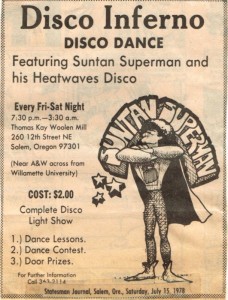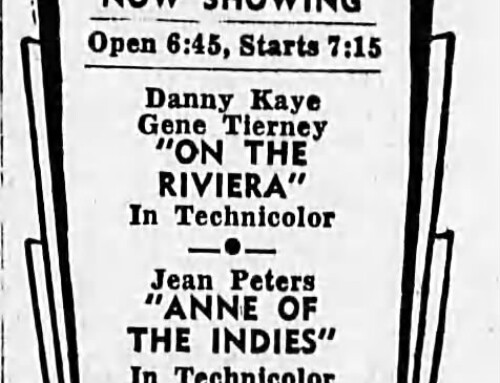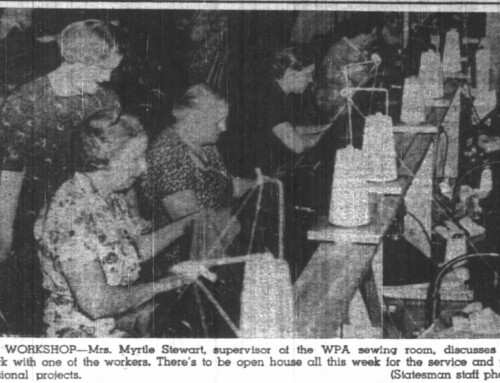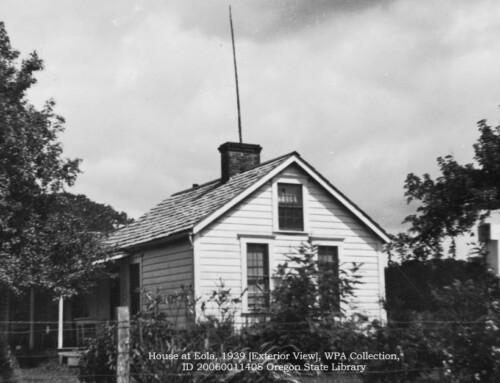There is something slightly ironic at the thought of a disco, called Disco Inferno, operating on the second floor of the Thomas Kay Woolen Mill, the song Burn, Baby Burn by the Whamms pounding out of the speakers, as six years after its opening in 1889, the beautiful, Victorian design wood structure burned to the ground to be replaced by the red brick building that stands today on the grounds of the Willamette Heritage Center. Disco fever swept the nation with the 1977 release of the movie Saturday Night Fever, starring a young John Travolta. By the summer of 1978, it was in full swing in Salem according to Capital Journal reporter Cynthia Reiner, who reported that discos were “popping up in Salem almost as rapidly as fast food outlets.”
Discos, short for discotheque, were places for dancing. Music was usually recorded instead of using live bands, and played non-stop by a disc jockey. Accompanied by a light show pulsating to the sound of the music, whirling strobes and blinding flood lights only added to the kinetic energy of the dancers. The music was characterized by a consistent beat geared for dancing and the volume was loud. Dance steps were stylized and routine, pulled from the rhumba, tango, swing and hustle, with a few moves thrown in from everywhere else, including gymnastics. Clothes were also a big part of the scene. Men in unbuttoned dress shirts, slacks and gold neck chains. Women in high heels and dresses with skirts that flared while they danced. Disco “silks” or nylon, acetate, rayon and other unnatural fibers added to the slinky, sexy vibe as you danced the night away.
The summer of 1978, disc jockey Dave Bowen, also known as the Suntan Superman, came to Mission Mill Museum with an idea for turning the second floor of the Thomas Kay Woolen Mill into the Disco Inferno. For $2 a person local dancers could get their fill of music and dancing non-stop from 7:30 p.m. to 3:30 a.m. Friday and Saturday nights. It took a 6 man crew to help Dave manage the light board, big cannon lights, and laser light show. Disco lady Brita Wilson assisted with him with DJ duties. Within a month, business was so successful that Dave expanded to a full week. He also added a lighted dance floor ala Saturday Night Fever which was boasted to be the largest lighted dance floor in Oregon. Friday and Saturday nights, the large 10,000 square foot room would fill with close to 500 people. The average age was 21.
After an unpleasant flurry of bad publicity and legal problems the disco closed down when Bowen was charged with arson at a rival youth disco, the Odyssey. It had only been open a few months. Don Flinn of Coffee, Tea or Stereo picked up the space after Bowen, re-naming the disco The Mill in 1979. Less than a year into the operation the museum foreclosed on his operation due to unpaid rent. He also left a local bank holding a note for several thousand dollars worth of improvements he had put into the disco space.
The third and final disco in the mill was Showcase Palace also known as Salem’s Youth Nightclub. Opened in time for New Year’s Eve 1979 by three enterprising young businessmen: Darrel Jabin, Mark La Nore, and John Miller. This time Mission Mill Museum negotiated for 60% of the profits. Anthony Reid, executive director of the museum, was optimistic despite having been stung twice. He told the Oregon Statesman in a December 1979 article, “I would say with the new management there’s a level of enthusiasm and a recognition of the audience which we’re aiming for, which was previously lacking. I have real hopes that this will be a successful venture.” Reid personally had little tolerance for the disco phenomenon, according to institutional records.
The Showcase Palace was open Friday and Saturday nights from 8 p.m. to 2 a.m. with an admission of $3 for singles, $5 for couples. Open to youth aged 13 to 20, its managers hoped to eventually tap into the Willamette University audience with weekday hours. Up to 499 people could be allowed in under fire code rules and two Marion County Sheriff’s Department reserves were employed to keep order and patrol the parking area. Soft drinks and candy were available for sale.
The Showcase Palace group seemed to know that they were on the tail end of the national disco swing and put into place some ideas to set them apart. For example, they offered live entertainment instead of recorded music and showcased local bands such as Lady Luck and disc jockey Ron Leonard from KFLY in Corvallis. Despite their energy and enthusiasm, the disco era at the Thomas Kay Woolen Mill came to a close.
This article was written by Kaylyn F. Mabey for the Statesman Journal where it was printed 22 May 2016. It is reproduced here for reference purposes.
References:
- Mission Mill Museum Association, Institutional Scrapbook, MMMA.200.0002
- Mission Mill Museum Institutional Records
- Statesman Journal, July 15, 1978
- Capital Journal, July 27, 1978
- Oregon Statesman, December 21, 1979







